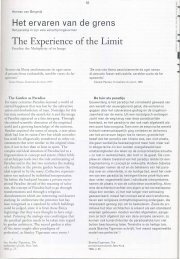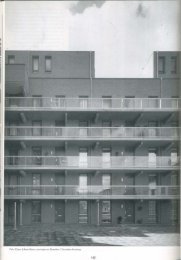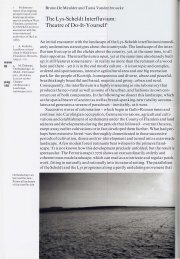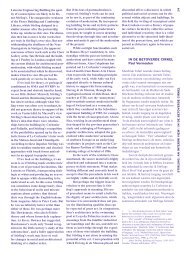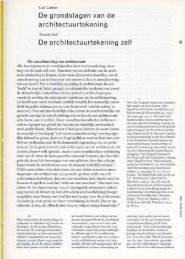Download PDF, 11 pagina's, 4,77 MB - OASE Journal for Architecture
Download PDF, 11 pagina's, 4,77 MB - OASE Journal for Architecture
Download PDF, 11 pagina's, 4,77 MB - OASE Journal for Architecture
Create successful ePaper yourself
Turn your PDF publications into a flip-book with our unique Google optimized e-Paper software.
ing technique, can only be healthy if, instead of<br />
exhausting itself in details, it draws its imaginative<br />
power from the grand <strong>for</strong>m ...<br />
(Excerpt from: 'Die Gartenmoderne -<br />
Ein Plagiat?', in: Gartenschijnheit, 6 [1925], No. 9)<br />
The garden of the future<br />
We now come to the heart of our query into the<br />
garden of the future: should gardens be beautiful?<br />
Based on thousands of years of gardening history,<br />
aided by a gardening life rich in experience, and the<br />
willpower to secure a future <strong>for</strong> a youthful era, our<br />
answer must be: No! All that is required of gardens<br />
is that they should exist, and nothing else.<br />
'Beautiful' gardens cannot be identified objective<br />
ly. The history of gardening has successively regis<br />
tered and approved green elegies and rigid terrace<br />
constructions, courtyards poor in plants and entire<br />
cities made out of screens of greenery, kitchen gar<br />
dens that were the pinnacle of rationality and the<br />
subtlest of orl).amental gardens solely devoted to<br />
beauty. And the more recent 'garden art' is practical<br />
ly bursting with <strong>for</strong>mal contradictions, alternating<br />
between sentimental landscape images and purely<br />
decorative gardens within the shortest of time spans.<br />
Nowadays, moreover, the high and mighty realm of<br />
garden art allows everything and nothing alike. Peo<br />
ple make do with modest floral cultivation and all<br />
the more immodest planting of public utilities such<br />
as cemeteries and playgrounds, in an ef<strong>for</strong>t to cope<br />
82<br />
tuinieren, is namelijk aileen dan levensvatbaar wanneer<br />
zij zich niet in details verliest, maar haar creatieve<br />
kracht put uit de grote vorm ...<br />
(Uit: 'Die Gartenmoderne- ein Plagiat?', in:<br />
Gartensch6nheit, 6 [1925], nr. 9)<br />
De tuin van de toekomst<br />
We komen tot de kern van onze vraag naar de tuin van<br />
de toekomst: moeten tuinen mooi zijn? Op basis van<br />
vele duizenden jaren tuingeschiedenis, ons gesteund<br />
wetend door een tuinleven rijk aan ervaringen, en<br />
krachtens de wil om een jeugdig tijdperk een eigen<br />
toekomst te geven, antwoorden wij: Nee! Allereerst<br />
horen tuinen er te zijn en niets meer dan dat.<br />
Of een tuin mooi is valt objectief niet te bewijzen.<br />
De tuingeschiedenis heeft achtereenvolgens groene<br />
elegieen en starre terrasconstructies, plant-arme<br />
binnenplaatsen en hele steden opgebouwd uit groene<br />
coulissen, de meest rationele nutstuinen en de meest<br />
geraffineerde siertuinen als ideaal gekend en ernaar<br />
beoordeeld. En de 'tuinkunst' van de nieuwe tijd staat<br />
gewoon bol van de <strong>for</strong>mele tegenstellingen, die binnen<br />
de kortste tijdspannes uiteenlopen van sentimentele<br />
landschapsbeelden tot pure tuindecoratie. Tegenwoor<br />
cftg is bovendien in het verheven rijk van de tuinkunst<br />
alles en niets geoorloofd. Men slaat zich zo goed en zo<br />
kwaad als het gaat, met een bescheiden verering van<br />
bloemen en des te onbescheidener beplanting van<br />
openbare voorzieningen als begraafplaatsen en speel<br />
plaatsen, door de geestel ijke leegte en het gebrek a an




